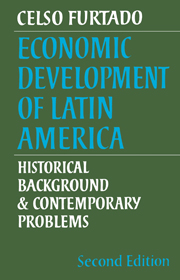Book contents
- Frontmatter
- Contents
- Tables
- Preface to the second edition
- Preface to the first edition
- Abbreviations
- Maps
- PART ONE FROM THE CONQUEST TO THE FORMATION OF NATION-STATES
- PART TWO ENTRY INTO THE SYSTEM OF INTERNATIONAL DIVISION OF LABOUR
- 4 The transformation of international trade in the second half of the nineteenth century and its impact on Latin America
- 5 Reorientation of the international economy in the present century
- 6 Some indicators of the degree of development reached in Latin America
- PART THREE THE TRADITIONAL STRUCTURAL PATTERN
- PART FOUR CHARACTERISTICS OF THE INDUSTRIALISATION PROCESS
- PART FIVE REORIENTATION OF DEVELOPMENT IN THE RECENT PERIOD
- PART SIX INTERNATIONAL RELATIONS
- PART SEVEN INTRA-REGIONAL RELATIONS
- PART EIGHT STRUCTURAL RECONSTRUCTION POLICIES
- Bibliography
- Index
5 - Reorientation of the international economy in the present century
Published online by Cambridge University Press: 25 January 2010
- Frontmatter
- Contents
- Tables
- Preface to the second edition
- Preface to the first edition
- Abbreviations
- Maps
- PART ONE FROM THE CONQUEST TO THE FORMATION OF NATION-STATES
- PART TWO ENTRY INTO THE SYSTEM OF INTERNATIONAL DIVISION OF LABOUR
- 4 The transformation of international trade in the second half of the nineteenth century and its impact on Latin America
- 5 Reorientation of the international economy in the present century
- 6 Some indicators of the degree of development reached in Latin America
- PART THREE THE TRADITIONAL STRUCTURAL PATTERN
- PART FOUR CHARACTERISTICS OF THE INDUSTRIALISATION PROCESS
- PART FIVE REORIENTATION OF DEVELOPMENT IN THE RECENT PERIOD
- PART SIX INTERNATIONAL RELATIONS
- PART SEVEN INTRA-REGIONAL RELATIONS
- PART EIGHT STRUCTURAL RECONSTRUCTION POLICIES
- Bibliography
- Index
Summary
Export expansion phase
The three decades preceding the First World War were a period of rapid economic development and some social change in Latin America as a whole: in Mexico, where the Porfirio Diaz administration created the conditions for a large inflow of foreign capital directed mainly into mineral production; in Chile, whose victory in the War of the Pacific against Bolivia and Peru enabled her to monopolise the sources of nitrate; in Cuba, where, even before independence was attained in 1898, the country's increasing integration into the United States market had brought about a dramatic expansion in sugar production; in Brazil, where the spread of coffee over the Sao Paulo highlands and the influx of European immigrants hastened the collapse of the slave economy; finally, in Argentina, where economy and society underwent drastic changes under the impact of the great wave of immigration and the penetration of substantial foreign capital.
A closer look at the three largest countries reveals the importance of the changes that occurred during this period. In Mexico, the population increased from 9.4 million in 1877 to 15.2 million in 1910. In the last of the nearly three decades of the Porfirio Diaz administration (1900-10), the annual average growth rate of the real per capita product was 3.1 per cent.
- Type
- Chapter
- Information
- Economic Development of Latin AmericaHistorical Background and Contemporary Problems, pp. 50 - 57Publisher: Cambridge University PressPrint publication year: 1977



